Florida school shooting: Where do US protests go from here?
- Published
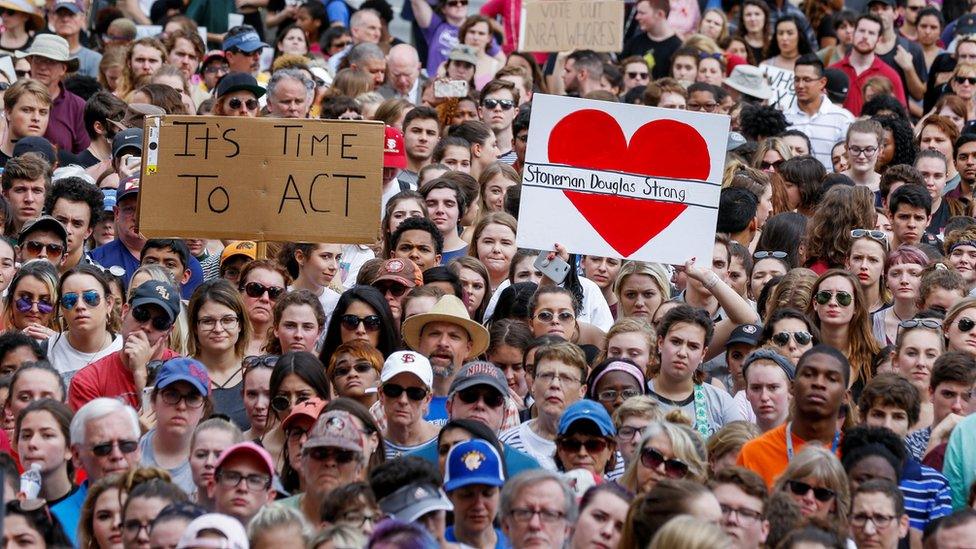
Students from Marjory Stoneman Douglas High School demanded reform to gun laws
At 14:21 on 14 February, gunman Nikolas Cruz entered Marjory Stoneman Douglas High School in Parkland, Florida, and began shooting.
Seven minutes later, he walked out, having shot dead 17 students.
About 40 hours later, one survivor, Cameron Kasky, became the first person to use the hashtag #NeverAgain on Twitter.
With those words, a new movement was born - one that, within a week, would see the school's students march to their state capitol to confront lawmakers and demand stricter gun laws.
The #NeverAgain movement, the momentum of which has barely slowed over the past week, has even managed to draw some early concessions from President Trump.
But it is not a movement that exists in isolation.
By one count, there have been 15 major protests on progressive issues, external in the year since President Trump took office, including two Women's Marches and one against a far-right rally in Charlottesville, Virginia.
The 16th such demonstration will be the March For Our Lives on 24 March, in which students, including those from Parkland, will demand an end to gun violence in schools.
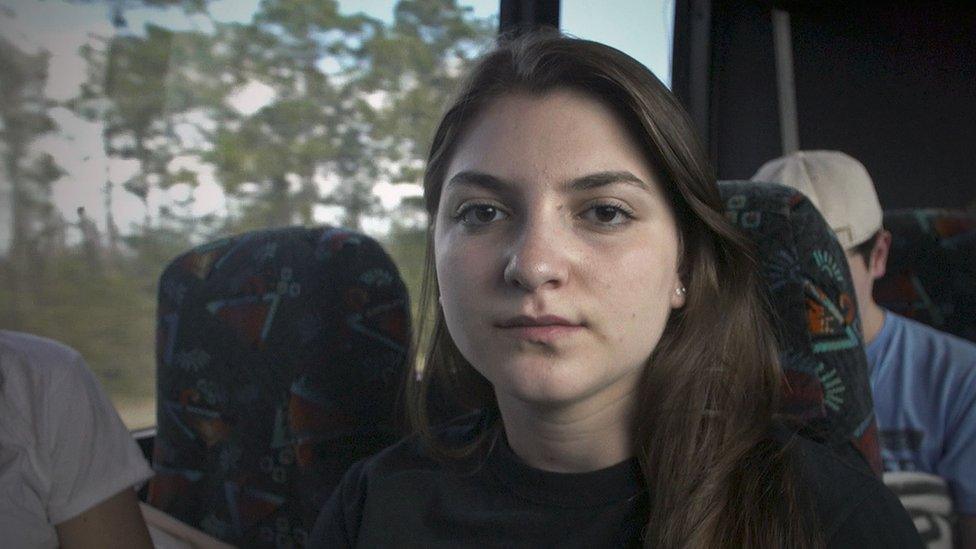
Rebecca Schneid: "None of us is surprised that this is how we reacted"
Rebecca Schneid, 16, survived the Florida shooting by hiding in a closet with 18 fellow students and teacher Melissa Falkowski.
Rebecca was one of the many students who travelled to Florida's capital Tallahassee this week to urge lawmakers to reform gun laws.
She acknowledges that other emerging movements have helped set a path for her and her fellow students to speak up, in particular #MeToo, that was created in the wake of abuse allegations against Hollywood mogul Harvey Weinstein and has rallied Democrats and Republicans alike.
"I think that this never would have happened if events of the past year hadn't occurred," she tells the BBC. "The shooting is a terrible thing to have happened. It's awful that it takes something like this and so many other things like it for us to finally act.
"But I do think with the other movements like #MeToo and the Women's March, we've seen a turning point. None of those powerful men in Hollywood expected something like that to happen. Lawmakers and the NRA [National Rifle Association] did not expect this to happen.
"None of us is surprised that this is how we reacted."
Around 100 students made the bus journey of more than seven hours to reach Florida's capital
Rebecca, who interviewed fellow students about #MeToo for the school newspaper last month, external, says there is a broader pattern of political engagement among students of her age, spurred in part by some of the policies of President Trump, but more broadly around a set of progressive issues.
She and her friends attended the Women's March in January, and she has supported other protests, including one for climate change awareness. She also says that some students who were not previously politically active have now become involved in #NeverAgain.
Generally, people attending such protests are likely to attend others on different issues.
Dana R Fisher, a professor of sociology at the University of Maryland and the author of the forthcoming book American Resistance, surveyed people taking part in the Women's March in Washington on 20 January.
She found that almost 80% had attended the same event in 2017, 41% were at the March for Science on 22 April last year and 26% had turned out for the People's Climate March a week later.
Those present were not there because of one particular issue, Prof Fisher found - participants cited an average of 2.7 issues that had brought them to the march.
"We are living in an amazing renaissance of democracy," she says.
Women's marches drew huge crowds in the US in January
Periods of protest in the US are not in themselves unusual, and larger demonstrations have happened even in recent years: millions turned out in 150 US cities in February 2003 to protest against the Iraq War, for example, and about a million people demanded the abolition of nuclear weapons in New York in 1982.
But Doug McAdam feels this period of public dissent is unprecedented in recent US history, even compared to the anti-Vietnam War and pro-civil rights demonstrations in which he took part in the 1960s and 70s.
Now a professor of sociology at Stanford University in California, he is an expert in social movements and feels there is a momentum gathering among different social movements "fuelled by a level of anger I have never seen in my lifetime".
"My daughters and my students say 'what about the 60s, that was similar?' But it wasn't. At all," he says.
"There were big divisions in the country and a level of anger. But Republicans and Democrats had a basis for bipartisan co-operation. Washington wasn't broken the way it is now."
How young conservatives view #NeverAgain
Different protest movements are thriving, Prof McAdam feels, because they are "all feeding off each other, rooted in a general notion of resistance".
But is it enough to simply have momentum?
Recent protests, including the Occupy movement against socio-economic inequality and those against President Trump's ban on people from some Muslim-majority nations, eventually petered out despite vast numbers turning out and the issues not going away.
"In general, movements run out of steam when their efforts don't bear fruit," Prof McAdam says. "Movements are exhausting things and people can burn out very quickly. And it can burn out even quicker if people sense their actions are not having an effect."
Instead, he says, the president may have inadvertently handed the #NeverAgain more momentum by offering an early concession - looking at banning so-called "bump stocks" that turn rifles into machine guns.
Had the president offered no concessions, he could have caused the movement to run out of steam early on, Prof McAdam says.
At various times over the past year and a half, President Trump has called protests healthy but also said "thugs" were turning out, external alongside paid protesters. Conservatives have not mobilised to anywhere near the same extent in that period.
But some methods employed by conservative movements are now being adopted by groups on the opposite end of the political spectrum.

Ezra Levin and Leah Greenberg of Indivisible
In the wake of the 2016 election result, Leah Greenberg and other former congressional employees, including her husband Eric Levin, decided to do something.
They took a look at what the Tea Party movement did in opposition to the Obama presidency - organise on a local level and oppose, oppose, oppose - and took a leaf out of their book.
They set up a Google document for people to suggest ideas for how to oppose the Trump agenda at a grassroots level, and named the movement Indivisible.
The document has been downloaded more than two million times, and Indivisible now employs 42 people who advise 6,000 different groups across the US, down to former book groups who have decided to become politically active.
Student Emma González to lawmakers: "Shame on you"
Groups in Indivisible's network who were not necessarily committed to gun control have rallied to support #NeverAgain and anti-gun violence groups in the past week, Ms Greenberg says.
#NeverAgain, she says, are quickly demonstrating what can be achieved by other burgeoning movements.
"Cultural transformation can often lead to policy changes," she says.
"We are already seeing a movement within what positions are acceptable within the Republican Party. We are seeing Republicans trying to figure out how they can hang on to some ground while giving up other positions."
As a gunman opened fire in a Florida high school, students inside reached for their phones.
The proof of whether progressive movements are succeeding in their aims, Prof Fisher says, may be in seeing whether the Democratic Party puts forward an agenda that can unite campaigners across those issues.
November's mid-term elections, during which Democrats will be aiming to challenge Republican control of Congress, are the first hurdle.
But she warns that short-term gains could "take some of the air out of" protest movements before they have fully matured.
Prof McAdam, meanwhile, says that if protest movements end up narrowing their focus on the the impeachment of Donald Trump as president, and are successful, they may not end up focusing on fixing institutional changes that got them out on to the streets in the first place.
And so protest movements are faced with some dilemmas: is it better for their cause for them to remain in opposition for longer? Might it be better not to seek too many gains too soon to avoid becoming complacent?
"I don't think there's any danger that the movement would feel like it's won if it takes back one or both houses of Congress," says Leah Greenberg, of Indivisible. In fact, she says, any such gains - as speculative as they are at this stage - could hand renewed momentum to protest movements.
As it stands, the #NeverAgain protesters aren't giving up.
"We are not afraid we are going to lose steam," Rebecca Schneid says. "We're young, we have time. We've got our whole lives ahead of us."
- Published18 February 2018
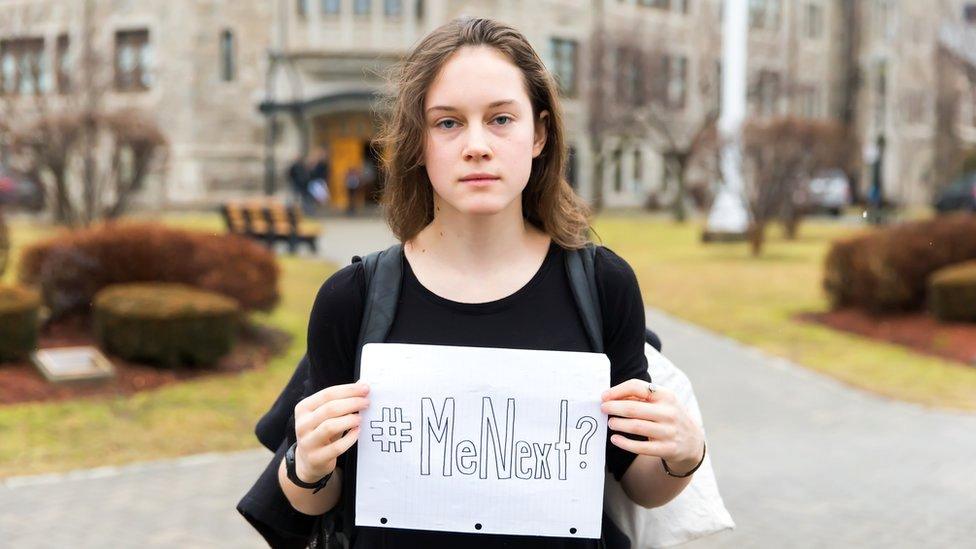
- Published24 February 2018
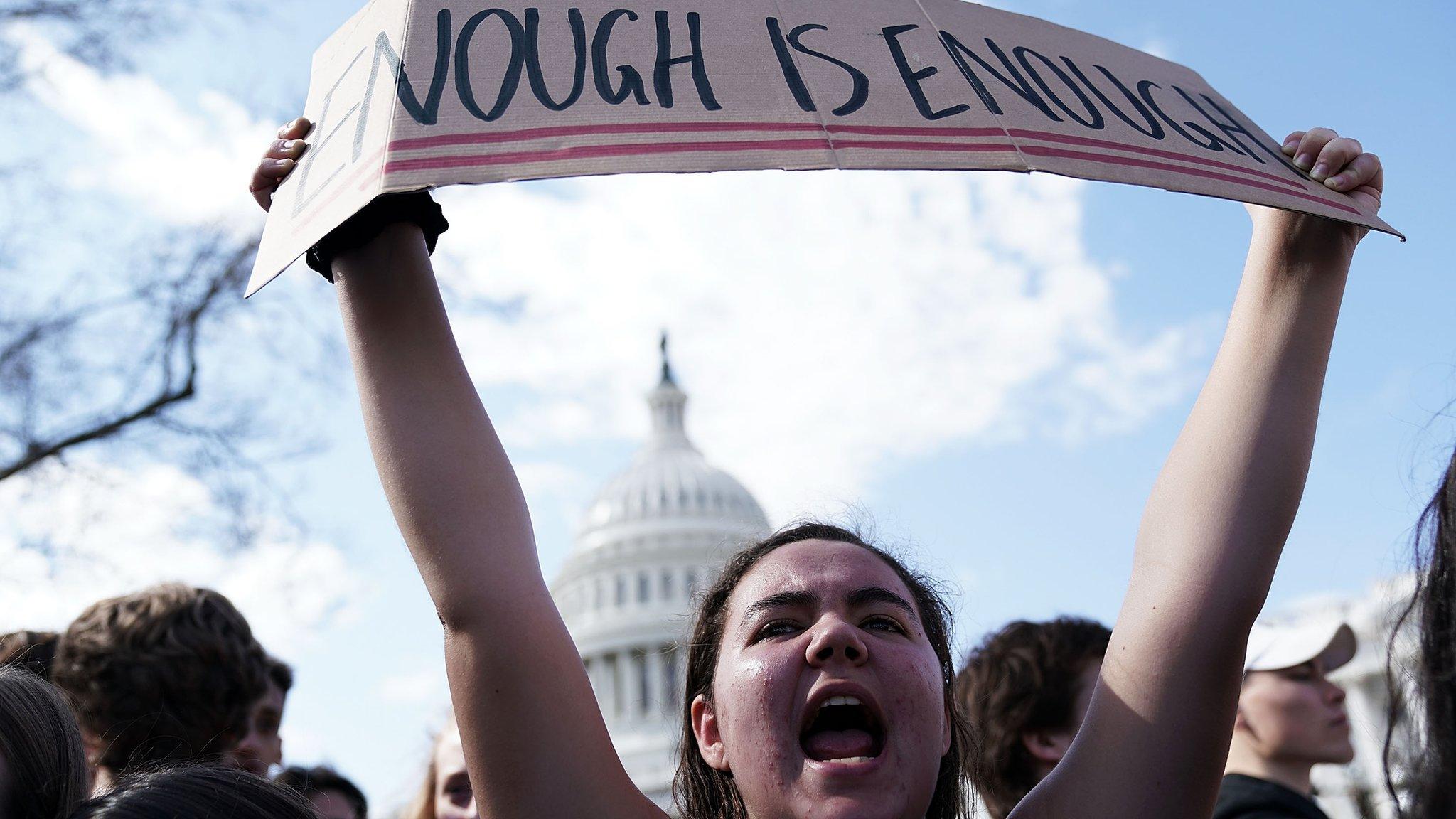
- Published22 February 2018
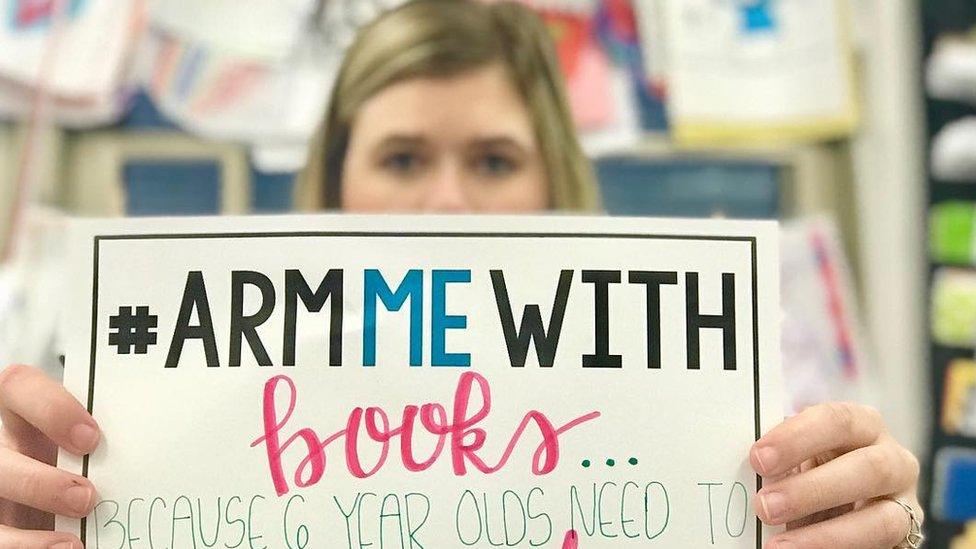
- Published16 February 2018

- Published19 February 2018
